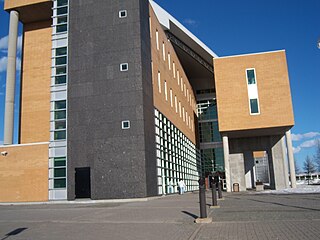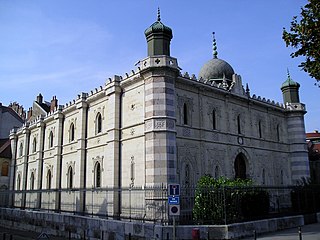
A synagogue, sometimes referred to by the Yiddish term shul and referred to by Reform communities as a temple, is a Jewish house of worship. Synagogues have a place for prayer, where Jews attend religious services or special ceremonies, have rooms for study, social hall(s), administrative and charitable offices, classrooms for religious school and Hebrew school, sometimes Jewish preschools, and often have many places to sit and congregate; display commemorative, historic, or modern artwork throughout; and sometimes have items of some Jewish historical significance or history about the synagogue itself on display.

Rouyn-Noranda is a city on Osisko Lake in the Abitibi-Témiscamingue region of Quebec, Canada.

Cochin Jews are the oldest group of Jews in India, with roots that are claimed to date back to the time of King Solomon. The Cochin Jews settled in the Kingdom of Cochin in South India, now part of the state of Kerala. As early as the 12th century, mention is made of the Jews in southern India by Benjamin of Tudela. They are known to have developed Judeo-Malayalam, a dialect of Malayalam language.

Abitibi-Témiscamingue is an administrative region located in western Québec, Canada, along the border with Ontario. It became part of the province in 1898. It has a land area of 57,736.50 square kilometres (22,292.19 sq mi) and its population was 146,717 people as of the 2016 Census. The region is divided into five regional county municipalities and 79 municipalities. Its economy continues to be dominated by resource extraction industries. These include logging, mining all along the rich geologic Cadillac Fault between Val-d'Or and Rouyn-Noranda, as well as agriculture.

The Université du Québec en Abitibi-Témiscamingue (UQAT) is a public university within the Université du Québec network, with campuses in Val-d'Or and Rouyn-Noranda. It takes its name from the region it primarily serves.

The history of the Jews in Luxembourg dates back to the 1200s. There are roughly 1,200 Jews in Luxembourg, and Jews form one of the largest and most important religious and ethnic minority communities in Luxembourg historically.
David Feuerwerker was a French Jewish rabbi and professor of Jewish history who was effective in the resistance to German occupation the Second World War. He was completely unsuspected until six months before the war ended, when he fled to Switzerland and his wife and baby went underground in France. The French government cited him for his bravery with several awards. After the war, he and his wife re-established the Jewish community of Lyon. He settled in Paris, teaching at the Sorbonne. In 1966, he and his family, grown to six children, moved to Montreal, where he developed a department of Jewish studies at the University of Montreal.

Historic synagogues include synagogues that date back to ancient times and synagogues that represent the earliest Jewish presence in cities around the world. Some synagogues were destroyed and rebuilt several times on the same site. Others were converted into churches and mosques or used for other purposes.
Synagogues may be considered "oldest" based on different criteria, and can be oldest in the sense of oldest surviving building, or oldest in the sense of oldest congregation. Some old synagogue buildings have been in continuous use as synagogues, while others have been converted to other purposes, and others, such as the Touro Synagogue, were shuttered for many decades. Some early established congregations have been in continuous existence, while other early congregations have ceased to exist.

The beginnings of the history of the Jews in Besançon go back to the Middle Ages, a period during which the Jews settled in the city attracted by its activity as a commercial place. The community was founded at the end of the 14th century and, due to its status as a free imperial city, Besançon remained one of the only territories in present-day France to tolerate Jews after their expulsion from the kingdom of France in 1394. The community was nevertheless expelled in turn from Besançon in the middle of the 15th century. The Jews made a tentative return to the city in the 18th century, but it was only after the French Revolution, which emancipated them, that their situation in the Franche-Comté capital stabilized. Although the Jewish community never exceeded 2,000 people except on the eve of the Second World War, it experienced great economic success during the industrial revolution at the end of the 19th century, when the Lipmann family founded LIP, a brand of watchmaking which then became one of the economic engines of the region and remained associated with the name of the city.

Congregation Dorshei Emet is a Reconstructionist synagogue in Hampstead, Quebec. It was founded in 1960 by Lavy Becker, who served as volunteer rabbi. Ron Aigen was hired as the congregation's first paid rabbi in 1976. Rabbi Boris Dolin joined the shul in 2016. Dorshei Emet constructed its first synagogue building in 1967. The congregation soon outgrew this structure, and built a larger one on the same site in 2003.

The history of the Jews in the Democratic Republic of the Congo can be traced back to 1907, when the first Jewish immigrants began to arrive in the country. The current Jewish Congolese population is mostly of Sephardi background.
Dorylas Moreau was a Canadian bishop of the Catholic Church who retired in 2019 for health reasons.
TVA Nouvelles is the news division of TVA, a French language television network in Canada.

Sonia Cotten is a Canadian writer living in Quebec.
The Great Park Synagogue is a Orthodox synagogue situated in Houghton, Johannesburg. The present building was consecrated in 2000, after the congregation vacated their long-time home, the Great Synagogue on Wolmarans Street, Hillbrow in 1994, after eighty years. The Wolmarans Street synagogue came to be known as the city's mother synagogue and "the crown jewel of Orthodox Judaism in South Africa." All large-scale Jewish events in Johannesburg were held in the building, and throughout its existence it was the seat of the country's chief rabbi. Northward migration by congregation members led to the synagogue closing its doors in 1994. The relocated synagogue was built on the model of the Great Synagogue, whose own architecture in turn was inspired by the Hagia Sophia. Great Park Synagogue was also the original name of the synagogue on Wolmarans Street before it became the Great Synagogue.
The Abitibi-Témiscamingue International Film Festival is an annual film festival, which takes place in Rouyn-Noranda, Quebec, Canada. The festival presents a program of Canadian and international films in late October and early November each year.

Jean-Paul Bordeleau was a Canadian politician. He represented the constituency of Abitibi-Est in the National Assembly of Quebec from 1976 to 1985 under the banner of the Parti Québécois.












